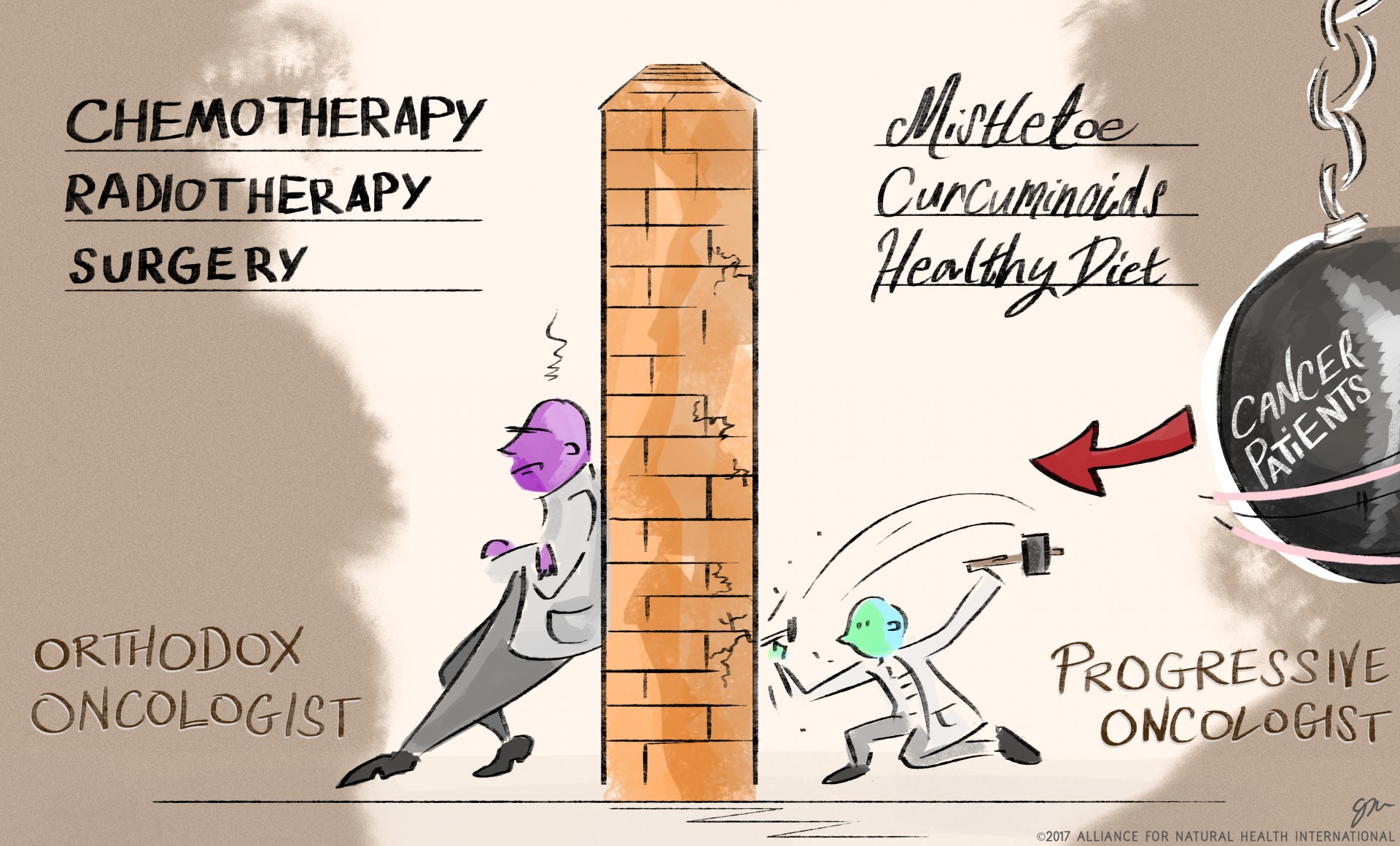
By Jerome Burne, investigative health journalist
Here’s a compelling and emotional argument, published this month (June) for trying a non-conventional cancer treatment on a patient who has run out of options from the official armoury.
“Only someone who is lucky enough to have never experienced the panic and angst generated by a diagnosis of cancer (or other life threatening condition) can contemplate ignoring complementary and integrative medicine.
It is easy for a doctor to dismiss it as unproven quackery, but very difficult then to give an answer to cancer patients in pain, with impossible nausea and vomiting, with drug-resistant permanent insomnia, with weight loss and cachexia, who are open to any reasonable solution in the hope of feeling better.”
So where do you think it came from. A reasonable guess would be the website of some site devoted to CAM (Complementary and Alternative Medicine) or maybe an American centre at a large hospital that takes a CIM (Complementary and Integrated Medicine) approach, using both drugs and natural treatments.
That’s why it came as a welcome surprise when I read it in a glossy journal about cancer – Cancer World – which is aimed at professionals and the general public and carries ads from drug companies and announcements about oncology conferences.
Written by the editor of the journal – Alberto Costa – it is an overview of what is happening with non-standard approaches and one of its conclusions is that that it is too late, and too simplistic, to just ignore complementary and integrative medicine.
A basic reason for this is that, as the introduction says, “around half of all cancer patients use therapies that are not part of mainstream medicine”. Denying the reality of how they regard their cancer and what they feel comfortable doing about it can’t still be an option when in other fields patient centred treatment is already a reality.
What’s more these patients are clearly not using CAM in an ignorant naïve way, believing every claim and happy to be fooled by the power of the placebo. In fact they are just the sort of self-determining patients that any doctor interested in working in partnership with their patients would surely welcome.
“Complementary and integrative (CIM) approaches”, writes Costa “are more likely to be used by female patients, and those who are younger, white, more highly educated and on a higher income.
Patients use these types of therapy for many reasons, including improving physical symptoms, supporting emotional health, boosting the immune system and improving quality of life. Some patients use CIM to relieve the side effects of conventional cancer treatments or to obtain a more holistic treatment, while others may be hoping to gain better control of their disease.”
Rather than ignoring their investigations and conclusions, as far too many oncologists do – ever tried asking an oncologist if there is diet that might improve their immune system? – The real question is why aren’t oncologists prepared to engage with all these areas which are obviously the ones of great importance to their patients? Also why are they apparently unconcerned that the standard approach has so few effective ways of addressing any of these issues?

The approach being set out here is precisely the one that has been promoted by UK, integrated cancer charity, Yes to Life, for the last decade. So it is interesting to learn that just over ten years ago “the European Society of Breast Cancer Specialists (EUSOMA) published a report and recommendations on the use of complementary and alternative medicine”.
These included ‘psychosocial and spiritual support’ and that randomised trials should contain modules that identify patients’ belief systems about complementary and alternative medicine, and establish whether it is being used concurrently, and support open and factual discussions about it.”
All great ideas but still a long way from being a reality on the ground. Again rather than attacking the lack of evidence for CAM and its possible harm, it seems reasonable to turn the tables. Why have oncologists and those responsible for our oncology system been so remiss in implementing such obviously desirable and patient friendly initiatives?
Then Costa tackles the ongoing issue of evidence. The official position that we don’t take CAM seriously because of a lack of evidence. What he makes clear is that even when the so-called gold standard RCT evidence is gathered, it is perfectly possible for official guidelines to ignore it.
He makes it clear that one of the understandable drivers of CAM is the fact that clinical oncology “is moving to a point in which the fight against the disease continues well beyond the transition to the metastatic stage, no matter how much this will cost, both financially and emotionally for patients and their caregivers.” This is why a few imaginative researchers have pushed promising CAM treatments that are cheaper and gentler such as mistletoe extract, into an RCT.
It was for advanced pancreatic cancer – not a type that boasts of much in the way of effective treatments. It found “significant survival benefit in a prospective randomised phase III trial in 220 patients with locally advanced or metastatic pancreatic cancer, with a median overall survival of 4.8 months for patients receiving Viscum album L extract compared with 2.7 months for patients on no anti-cancer therapy”.
Yet a few years later the American body that advises of treatments clinicians should use (the PDQ of the US National Cancer Institute) concluded that; “At present, the use of mistletoe cannot be recommended outside the context of well-designed clinical trials”. It’s an old old story but would that have been the conclusion had mistletoe been a drug? There is one sort of evidence-based medicine for drugs and a quite different model for CAM.
He mentions an attempt to get round this block in the case of curcumin. Despite over 120 clinical trials the American Cancer Society website dismisses it on the usual grounds – no RCT. Unusually researchers have come back agreeing this is the case but arguing for more time to perfect delivery systems. “You should give us the time to see whether it will be more effective when put in formulations such as liposome, and standardised, turning it into a modern drug, like many others that originate from plants.”
One promising development is a recent document from the World Health Organization outlining a strategy for dealing with CAM over the next ten years. Among the recommendations are ‘integrating complementary medicines into national health systems’.
It’s clearly all too easy to ignore recommendations about CAM but there is a new spirit abroad about getting institutions – such as ones concerned with politics or economics, to work for those they have been set up to serve. It's time that such a change began to be implemented within oncology. As Costa says: “What is really needed is more patient empowerment”.







Comments
your voice counts
22 June 2017 at 5:48 am
The message is spreading , t.h.c cannabis oil is working fantastically well . Along with other regimes. Why won't they publish their data ? Is it because 97% of the time, you cannot poison your way back to health ??????
22 June 2017 at 11:47 am
Research began 1902, when it was rare!! Today,after 115 yrs research, trillions of $$££s, specialist equipment, 100s of cancer specialists, hospitals, dozens of drugs, numerous breakthroughs etc..and best conventional medicine can offer is toxic treatment that damages internal organs, bone marrow, blood, does cure can acually cause cancer! And cancer is now endemic!! I'd say that's a resounding failure!!
www.facebook.com/activecancertherapysupport
,
22 June 2017 at 6:59 pm
Health freedom is about choosing the protocol that fits the patient. If I had cancer, I wouldn't go anywhere near mainline medicine's treatment. This is because I have been allergic to every pharmaceutical drug I've ever been prescribed. Meanwhile natural supplements have stopped health problems every time. I stopped my eye floaters with a concoction of vitamins and minerals. I stopped my migraines with others. Mainline medicine can't cure either of these conditions. So it isn't idiotic that I wouldn't use the mainline route.
25 June 2017 at 6:35 pm
Leigh, How did you learn what to use? I want to get rid of floaters.
Your voice counts
We welcome your comments and are very interested in your point of view, but we ask that you keep them relevant to the article, that they be civil and without commercial links. All comments are moderated prior to being published. We reserve the right to edit or not publish comments that we consider abusive or offensive.
There is extra content here from a third party provider. You will be unable to see this content unless you agree to allow Content Cookies. Cookie Preferences